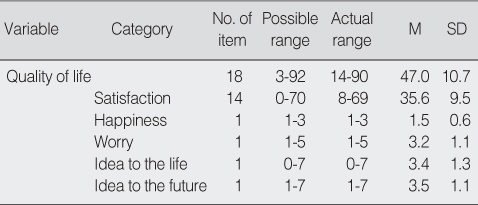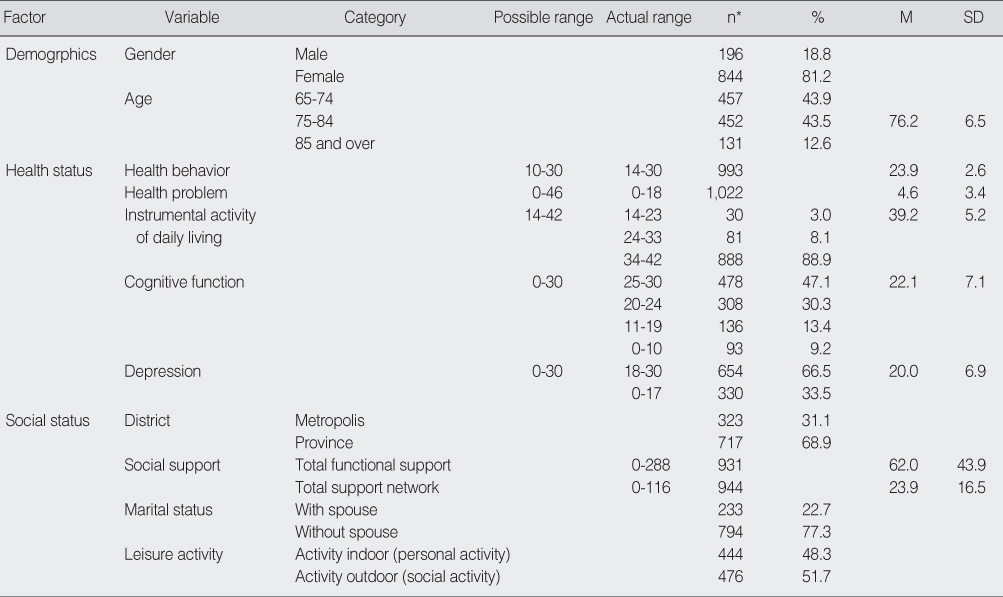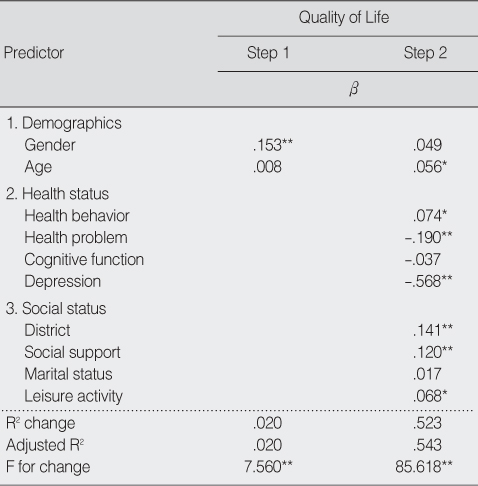Articles
- Page Path
- HOME > J Korean Acad Nurs > Volume 38(5); 2008 > Article
-
Original Article
- Quality of Life in Low Income Korean Aged
- Hye-Ryoung Kim, Kasil Oh, Kyong-Ok Oh, Sun-Ock Lee, Sook-Ja Lee, Jeong-Ah Kim, Hoa-Yun Jun, Jung-Hee Kang
-
Journal of Korean Academy of Nursing 2008;38(5):694-703.
DOI: https://doi.org/10.4040/jkan.2008.38.5.694
Published online: October 30, 2008
1Associate Professor, Department of Nursing, Inje University, Busan, Korea.
2Professor, College of Nursing, Yonsei University, Seoul, Korea.
3Professor, Department of Nursing, Chungnam University, Daejeon, Korea.
4Professor, Department of Nursing, Korean National Open University, Seoul, Korea.
5Professor, College of Nursing, Korea University, Seoul, Korea.
6Professor, Department of Nursing, Semyung University, Jecheon, Korea.
7Professor, Department of Nursing, Dongnam Health College, Suwon, Korea.
8Associate Professor, Department of Nursing, Kyungbok College, Pocheon, Korea.
- Address reprint requests to: Kim, Hye-Ryoung. Department of Nursing, Inje University, 633-165 Gaegeum-dong, Busanjin-gu, Busan 614-735, Korea. Tel: 82-51-890-6835, Fax: 82-51-896-9840, nurhrk@inje.ac.kr
Copyright © 2008 Korean Society of Nursing Science
Abstract
-
Purpose
- The purpose of this study was to identify the quality of life and its predictors in low income Korean aged.
-
Methods
- This was a predictive correlational study. An accessible sample from the population of people who were 65 and over and were supported by the basic livelihood security system was 1,040. Quota sampling with strata of state division in the nation was chosen. Quality of life and its predictors in the subjects were measured.
-
Results
- The mean quality of life in the subjects was 47.0±10.7. Predictors of this study significantly explained 54.3% of the total variance of quality of life. Depression was the most significant predictor of quality of life. Health problems, district, social support, leisure activity, and health behavior had effects on quality of life.
-
Conclusion
- This finding indicates that quality of life in lower income Korean aged is different from other populations by economic status. Demographics, health status and social status were predictors of quality of life in the aged with a small income.
- 1. Andrew FM, Withey SB. Social indicators of well-being: Americans perceptions of life quality. 1976;New York, NY, Plenum.
- 2. Buttler J, Ciarrochi J. Psychological acceptance and quality of life in the elderly. Quality of Life Research. 2007;16:607–615.ArticlePubMedPDF
- 3. Byoun JH, Nam JJ, Kim ES, Hong MS, Kim HR, Hwang NM, et al. Goal attainment and strategy development for health promotion in the people of Seoul. 1998;Gwacheon, Ministry of Health and Welfare.
- 4. Choi YH. A study on the correlations among the depression, social support and quality of life of the elderly in rural areas. Journal of Korean Academy of Community Health Nursing. 2004;15:237–245.
- 5. Chung KH, Cho AJ, Oh YH, Byun JK, Byoun YC, Mun HS. The year of 1998 national survey on life and health, and welfare need in the older adult in Korea. 1998;Seoul, Korea Institute for Health and Social Affairs.
- 6. Chung KH, Oh YH, Seok JE, Do SR, Kim CW, Lee YK, et al. The year of 2004 national survey on life and health, and welfare need in the older adult in Korea. 2005;Seoul, Korea Institute for Health and Social Affairs.
- 7. Jung IK, Kwak DI, Shin DK, Lee MS, Lee HS, Kim JY. A reliability and validity study of Geriatric Depression Scale. Journal of Korean Neuropsychiatric Association. 1997;36:103–112.
- 8. Kang JH. The effect of a social support program on burden and well-being in caregivers of elderly people with dementia living in the community. 2003;Seoul, Yonsei University. Unpublished doctoral dissertation.
- 9. Kang KS. Social support and quality of life for the elderly in rural areas. Journal of Korean Academy of Community Health Nursing. 2003;14:375–384.
- 10. Kim HR. Health status among community elderly in Korea. Journal of Korean Academy of Nursing. 2003;33:544–552.ArticlePubMedPDF
- 11. Korea National Statistics Office. Statistics for the elderly. 2006;Seoul, Korea National Statistics Office.
- 12. Kwon JD. The research of Korean dementia family: Development of the measurement tool and model for the caregiving. 1995;Seoul, Hong Ik Jae.
- 13. Low G, Molzahn AE. Predictors of quality of life in old age: A cross-validation study. Research in Nursing & Health. 2007;30:141–150.Article
- 14. Ministry of Health and Welfare. The guidebook for visiting nurse: Korean version of Mini-Mental State Exam. 1999;Gwacheon, Ministry of Health and Welfare.
- 15. Ministry of Health and Welfare. Basic livelihood security. 2007;11;Retrieved November 10, 2007. from http://team.mohw.go.kr/blss/.
- 16. Munro BH. Statistical methods for health care research. 2001;Philadelphia, PA, Lippincott William & Wilkins.
- 17. Norbeck JS, Linsey AM, Carrieri VL. The development of instrument to measure social support. Nursing Research. 1981;30:264–269.PubMed
- 18. Oh K. Family functioning and social support of Korean families with mentally-retarded children. 1984;Texas, USA, Texas Women's University. Unpublished doctoral dissertation.
- 19. Oh K, Cho WJ, Kim E. Feasibility and effectiveness of community involvement in community health practitioner activities. 1992;Seoul, Yonsei University. Unpublished manuscript.
- 20. Oh YH, Seok JE, Kwon JD, Kim JS, Park YR, Lim JG. Old person's quality of life and policy Implications. 2005;Seoul, Korea Institute for Health and Social Affairs.
- 21. Park ES, Kim SJ, Lim SI, Chun YJ, Lee PS, Kim HJ, et al. A study of factors influencing health promoting behavior and quality of life in the elderly. Journal of Korean Academy of Nursing. 1998;28:638–649.ArticlePDF
- 22. Paskulin LM, Molzahn A. Quality of life of older adults in Canada and Brazal. Western Journal of Nursing Research. 2007;29:10–26.PubMed
- 23. Puts MT, Shekary N, Widdershoven G, Heldens J, Lips P, Deeg DJ. What does quality of life mean to older frail and non-frail community-dwelling adults in the Netherlands? Quality of life Research. 2007;16:263–277.ArticlePubMedPDF
- 24. Sarvimäki A, Stenbock-Hult B. Quality of life in old age described as a sense of well-being, meaning and value. Journal of Advanced Nursing. 2000;32:1025–1033.ArticlePubMed
- 25. Sohn S. A comparative study on the quality of life of the elderly and its' affecting factors between rural and urban areas. Journal of the Korean Gerontological Society. 2006;26:601–615.
- 26. tenzelius K, Westergren A, Thomeman G, Hallberg IR. Patterns of health complaints among people 75+ in relation to quality of life and need of help. Archives of Gerontology and Geriatrics. 2005;40:85–102.ArticlePubMed
- 27. Tannenbaum C, Ahmed S, Mayo N. What drives older women's perceptions of health-related quality of life? Quality of Life Research. 2007;16:593–605.ArticlePubMedPDF
- 28. World Health Organization Quality of Life Group. The World Health Organization Quality of Life assessment: Position paper from the World Health Organization. Social Science and Medicine. 1995;41:1403–1409.PubMed
- 29. Yesavage JA, Brink TL, Rose TL, Lum O, Huang V, Adey M, et al. Development and validation of a geriatric depression screening scale: A preliminary report. Journal of Psychiatric Research. 1983;17:37–49.Article
- 30. Youn BS, Jung WJ, Lee HS, Yoeun HC, Han SD, Park JH. Quality of Life in Korean: Implications and Policy. 1996;Seoul, Korea Institute for Health and Social Affairs.
REFERENCES
Figure & Data
REFERENCES
Citations

- Quality of life of low-income adults
Daniel Puciato, Michał Rozpara, Marek Bugdol, Tadeusz Borys, Teresa Słaby
Work.2023; 74(2): 631. CrossRef - Health literacy, treatment adherence, bone mass density and health-related quality of life among Iranian older adults with osteoporosis
Roghayeh Aghajanloo, Haidar Nadrian, Bahman Baraei, Shayesteh Shirzadi, Parvin Sarbakhsh, Kahdijeh Keshavarzian, Nafiseh Ghassab-Abdollahi, Vijay Kumar Chattu
International Journal of Health Promotion and Education.2023; 61(5): 227. CrossRef - Factors Related to Depression and Mental Health That Affect the Quality of Life of the Elderly
Ji Eun Park, Ryoung Choi, Hye-jin Kim
Journal of Environmental and Public Health.2022;[Epub] CrossRef - Mind Over Matter: Mindfulness, Income, Resilience, and Life Quality of Vocational High School Students in China
Shannon Cheung, Xiaoxia Xie, Chien-chung Huang
International Journal of Environmental Research and Public Health.2020; 17(16): 5701. CrossRef - The impact of basic livelihoods condition on the current smoking: Applying the counterfactual model
Minhyeok Choi
Korean Journal of Health Education and Promotion.2019; 36(1): 53. CrossRef - The effects of medication adherence and health literacy on health‐related quality of life in older people with hypertension
Nam Hee Park, Mi Sook Song, So Young Shin, Ji‐hye Jeong, Hyo Young Lee
International Journal of Older People Nursing.2018;[Epub] CrossRef - Social Network, Self-Care Agency and Quality of Life of High-risk Beneficiaries in Case Management of Medicaid
Ju Young Park, Jung Tae Son
Journal of Korean Academy of Community Health Nursing.2017; 28(4): 421. CrossRef - Quality of life and national pension receipt after retirement among older adults
Yeong Jun Ju, Kyu‐Tae Han, Hyo Jung Lee, Joo Eun Lee, Jae Woo Choi, In Seon Hyun, Eun‐Cheol Park
Geriatrics & Gerontology International.2017; 17(8): 1205. CrossRef - A study on the Relationship among Depression, Walking and Quality of Life for the Elderly -Focusing on the Moderation Effects of Walking-
Hee-Seung Song
Journal of Digital Convergence.2016; 14(8): 515. CrossRef - Factors Influencing Self Determination for Withdrawing Life-Sustaining Treatment of the Community Dwelling Elderly
Hyun Sook Kim, Hye Kyoung Jang, Sung Rae Shin
Korean Journal of Adult Nursing.2016; 28(3): 334. CrossRef - The Effects of Hypertension Health School Program on Hypertension-related Knowledge, Self-efficacy, Self-care Behavior and Physiological Parameters in Hypertensive Patients
Koung Oh Chang
Journal of muscle and joint health.2016; 23(1): 49. CrossRef - The Effects of a Pilates Exercise Program using Self-Efficacy Sources in Elderly Women
Choon-Ji Lee, Yeon-Hee Choi
Journal of Environmental Science International.2015; 24(1): 117. CrossRef - The Relationships among Quality of Life and Stress, Health-related Habits and Food Intake in Korean Healthy Adults Based on 2013 Korea National Health and Nutrition Examination Survey
Su Bin Lee, Hyun Jin Choi, Mi Joung Kim
Korean Journal of Community Nutrition.2015; 20(6): 411. CrossRef - The Effect of Case Management Program for Hypertensive Patient
Jung-Soon Chung, Sun-Ock Lee
The Journal of Korean Academic Society of Nursing Education.2014; 20(2): 321. CrossRef - Factors Influencing the Quality of Life in Low- Income Elders Living at Home: A Literature Review
Chung-Min Cho
Journal of Korean Public Health Nursing.2013; 27(2): 372. CrossRef - Factors Influencing the Health-Related Quality of Life by Age among Vulnerable Elderly Women
Yun-Hee Kim
Journal of the Korea Academia-Industrial cooperation Society.2013; 14(3): 1342. CrossRef - Effects of a Recreational Combination Gymnastics Program for Old-old Women
Yeon Hee Choi, Choon Ji Lee
Journal of Korean Academy of Nursing.2012; 42(6): 843. CrossRef - A Study on Social Support Networks for Each Life-cycle Stage of Adults
Chu-Ja Jeong, Sun-Ock Lee, Jung-Hee Kang, Jeong Ah Kim, Hye-Ryoung Kim, Kyong-Ok Oh, Sook-Ja Lee, Hoa-Yun Jun, Sung Kyung Hong
The Journal of Korean Academic Society of Nursing Education.2012; 18(3): 436. CrossRef - The Effects of Related Factors on Health-related Quality of Life for the Frail Elderly
Eun Shil Yim, Kyoung Hee No
Journal of Korean Academy of Community Health Nursing.2010; 21(1): 12. CrossRef - Effects of Cognition Promoting Program on Cognitive Function, Depression and Quality of Life in Elderly
Hye-Soon Kim, Yeo-Jin Yi, Kwang-Hi Park, Un-Ku Kang, Byung-Mun Lee
The Journal of the Korea Contents Association.2010; 10(8): 227. CrossRef - Factors influencing Health-related Quality of Life in Korean Medicaid Beneficiaries
Sun-Woo Hong
Journal of Korean Academy of Nursing.2009; 39(4): 480. CrossRef
Description of Quality of Life (N=922)
Predictors of Quality of Life
*Missing value excluded.
Summary of Hierarchical Regression Analysis for Variables Predicting Quality of life
*p<.05; **p<.001.
*Missing value excluded.
*p<.05; **p<.001.
 KSNS
KSNS
 E-SUBMISSION
E-SUBMISSION



 Cite
Cite

